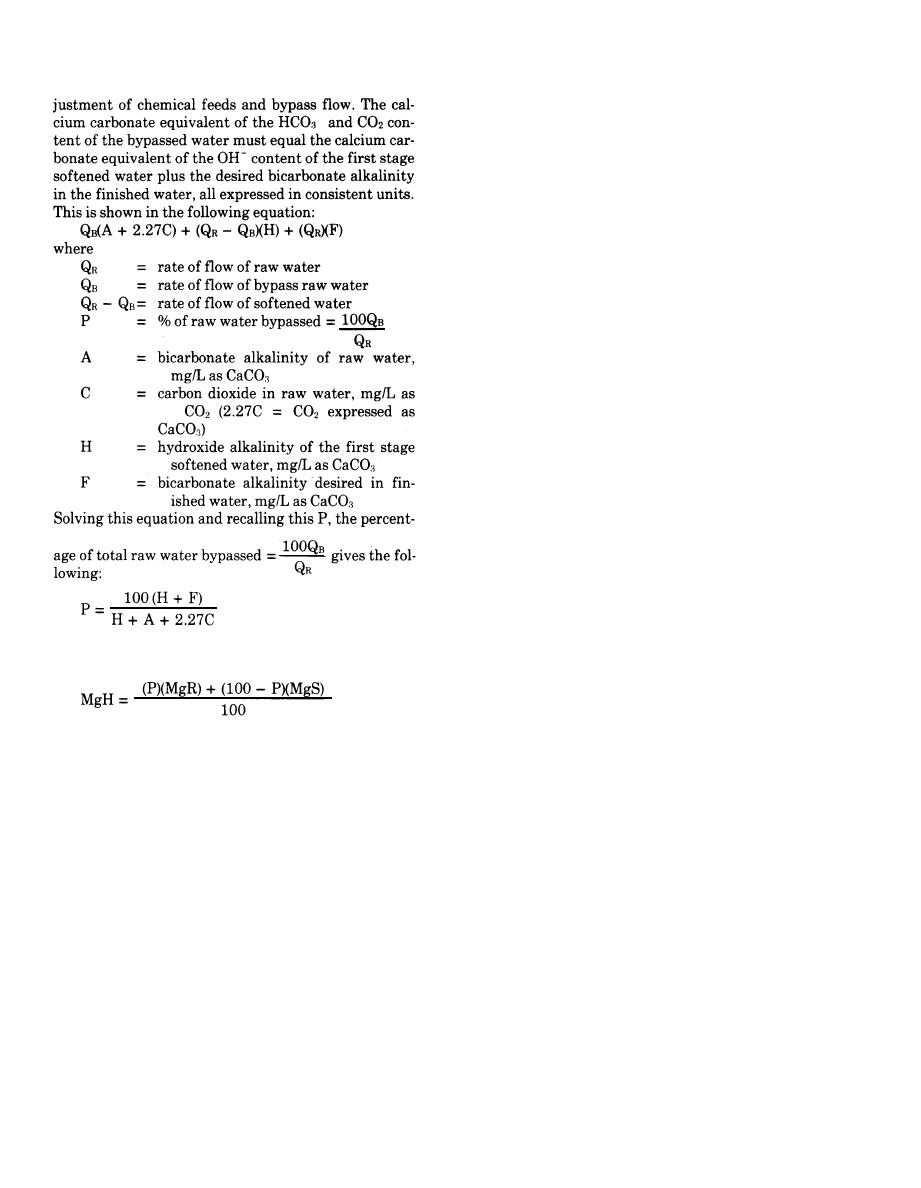
TM 5-813-3/AFM 88-10, Vol 3
nese removal. The high pH achieved insured essential-
ly complete precipitation of any iron and manganese
present in the raw water.
(d) Clarification. Lime softening provides excel-
lent coagulation and clarification as a result of the pre-
cipitation of magnesium hydroxide plus a large
amount of calcium carbonate.
(9) Softening plant design. The equipment, bas-
ins, and filters required for lime, lime-soda ash, lime-
caustic, or split treatment softening are generally
similar to the facilities used in conventional coagula-
tion-filtration plants. Two stages of treatment are
usually advisable. The design of a lime-soda ash or
similar softening plant is a complex and difficult task
requiring the services of engineers experienced in proj-
ects of this kind. Their assistance should be sought in
early stages of project planning.
(a) Mixing equipment, One problem encoun-
tered at softening plants is vibration of rapid mixing
devices due to nonuniform deposits of calcium carbon-
ate scale._ Frequent cleaning of the mixer may be re-
quired. The frequency of such cleaning can be reduced
by recirculation of previously precipitated calcium car-
bonate sludge from the settling basin to the rapid-mix
chamber. Parshall flumes can serve as mixing devices.
(b) Flocculation and clarification. Each separate
stage of flocculation and clarification should have a to-
tal detention time at design flow of about 2.5 hours, 30
minutes for flocculation and 2 hours for clarification.
Average depths of both flocculation and clarification
The magnesium hardness of the finished water can be
units should be 8 to 15 feet. The overflow rate in clari-
estimated from the following:
fiers at design flow should be about 0.75 gpm per
square foot.
(c) Sludge removal and recirculation. First-stage
settling basins shall have mechanical sludge removal
MgH = magnesium hardness of finished water in
equipment. Such equipment is also desirable in the sec-
mg/L
ond-stage basins which follow recarbonation. Sludge
MgS = magnesium hardness of the first stage sof-
recirculation is generally desirable except during oc-
tened water in mg/L
currences of severe taste and odor problems. Recycling
MgR = magnesium hardness of the raw water in
of a portion of the settled sludge, which is high in cal-
mg/L
cium carbonate, to the rapid-mix chamber is effective
P = `/o bypass water
in promoting the softening reactions, especially car-
(8) Incidental benefits of lime softening.
bonate precipitation. Where_ presedimentation is em-
(a) Disinfection. Excess lime provides excellent
ployed, recycling sludge to the presedimentation basin
bactericidal treatment, especially at pH values above
influent will enhance the performance of the presedi-
10.5. Lime treatment, while not a substitute for chlori-
mentation basin.
(d) Solids contact units. Solids contact type ba-
nation, is an effective supplement,
(b) Reduction of dissolved solids. Removal of
sins may be used at many softening plants, particular-
carbonate hardness by lime treatment results in reduc-
ly those treating ground water, These basins provide
tion in the total dissolved solids content of the water.
the functions of mixing, sludge recirculation, sedimen-
All reaction products of lime softening are relatively
tation and sludge collection in a simple compact unit.
insoluble. The lime added to the water, as well as the
Basins of this type, if properly sized, will provide ef-
carbonate hardness constituents in the water, are
fective softening and clarification treatment. Overall
largely precipitated.
basin depths of 10 to 15 feet should be used, and the
unit should be designed so that the softening slurry is
is also highly effective as a means of iron and manga-
recirculated through the center chamber at a rate of
2-22


 Previous Page
Previous Page
